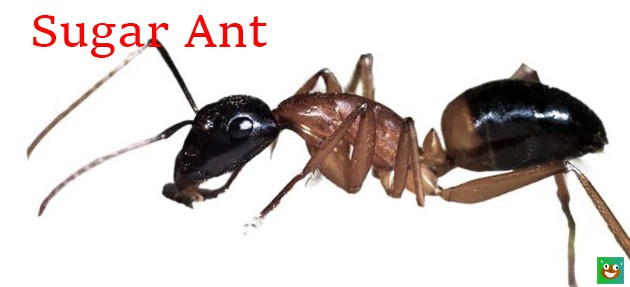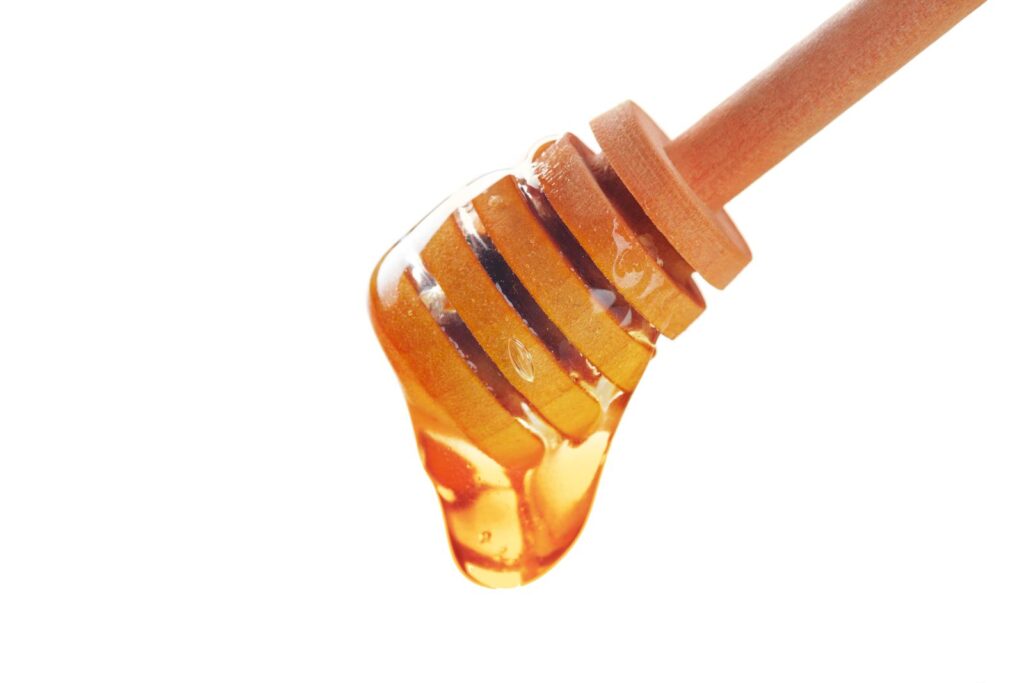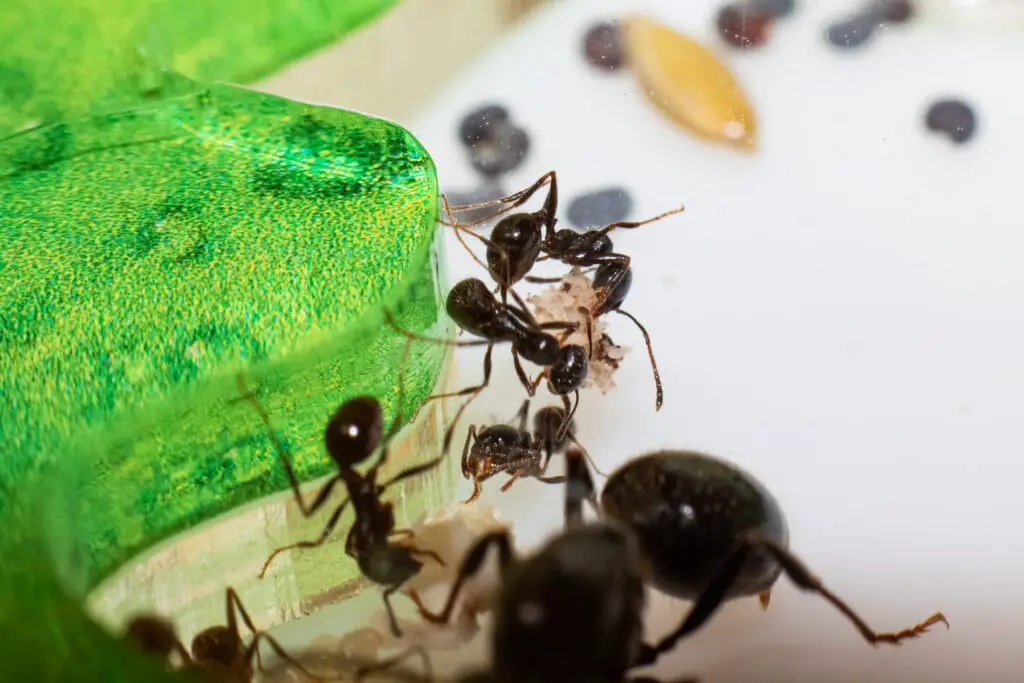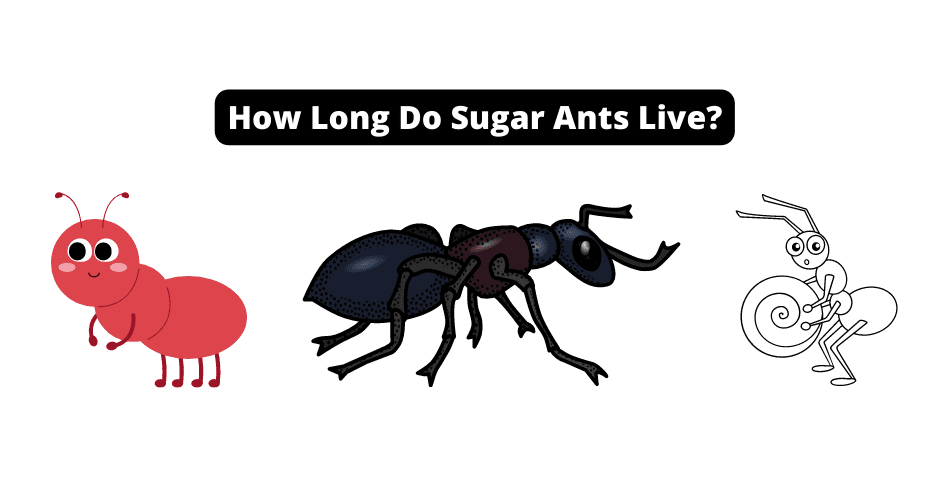To begin with, in the United States, the term “sugar ant” is an encompassing term used to refer to a range of indoor and outdoor ants whose primary food source is sugar or sweet stuff.
In etymology, “sugar ant” actually refers to a specific Australian ant species, the banded sugar ant.
For the rest of this write-up, sugar ant refers to any ants that invade your living space foraging for sugary food, which is the terminology from the united states.
Due to this, the lifespan of the sugar ants will depend on the ant species you’re dealing with.
And to avoid complicating things, ants have a caste system comprised of the queen, the workers, and the males.
The males live shorter than the workers, and the queen ant in all species outlives the other ant types.
This post will dive deep into the sugar ant umbrella, decoding the lifespan of all those pests you have seen invading your kitchen.
As you’ll see from later in the post, understanding the type of ant that has invaded your home is crucial in ant control.

What Are Sugar Ants?
Sugar ants refer to a variety of ants that prefer and crave sugars.
Sugar ants invade your home and trash bins to feed on sugary foodstuff like syrups, honey, peanut butter, or jams.
Sugar ants love sweet food.

Depending on your state, the typical indoor species are Argentine ants, pavement ants, odorous house ants, acrobat ants, black garden ants, and pharaoh ants.
The carpenter ant is one problematic indoor ant whose primary presence in the house is not seeking sugars.
The carpenter ant colony lives in nests in wooden structures.
Noticing these ants in your pantry means you have a double problem; a probability that they’ve invaded your wooden structures along with the kitchen infestation problem.
Before getting rid of sugar ants, you need the correct sugar ant identification.
Why?
Since sugar ants constitute a wide variety of ants, the ideal ant treatment for your sugar ant infestation depends on the species.
Relevant Viewing:
Are sugar ants hard to get rid of?
The ease of getting rid of sugar ants depends on several factors.
As emphasized throughout this article, the species is probably the most important consideration.
Species with short ant life cycles, like the pharaoh ants, reproduce faster, replenishing their colonies to compensate for the shorter lifespans.
Nesting habits also depend on species.
Sugar ants that make nests behind walls and crevices are more challenging to get rid of than those that live in the soil.
In nesting terms, carpenter ants are the most difficult to control because they live inside wood.
They also have satellite galleries where they hide the queen when they feel threatened.
The environmental conditions will also affect the ease or difficulty of getting rid of sugar ants.
Where ants’ living conditions are favorable, with plenty of food and water, no prey, and few disturbances, the sugar ant colony will thrive, making it harder to get rid of.
Lastly, how long the sugar ants can live complicates the eradication process.
It’s harder to get rid of ants with long lifespans, such as the pavement ants, than those with shorter ones, like the pharaoh and odorous house ants.

How long does a sugar ant queen live?
In general, the queen tends to live longer in all species of ants, outliving the female and male sugar ants. Again food availability and a secure living habitat determine how long a queen lives, essentially affecting a colony’s lifespan.
Queen ants with long lifespans pose a persistent problem.
To eliminate a sugar ant problem, killing the queen is mandatory.
Spraying the trail of ants may keep the ants away for a while. But the ants can quickly reappear, and the problem will only disappear once you destroy the queen.
Queens live a couple of months to several years, depending on the species.
How long does a worker sugar ant live?
The ants you spot in the kitchen or trash are workers (sterile female ants) and are the first sign of a sugar ant problem.
They invade kitchens for food to feed the queen and the colony.
In naturally occurring environments (not ant-keeping), they live longer than the male ants but shorter than the queen.
Again, the lifespan of sugar ant workers depends on the species.
Pharaoh ant worker ants live for about ten weeks, carpenter ants for six to twelve weeks, but pavement worker ants can live for up to 7 years.
Note that to get rid of colonies using sugary foods in the form of ant bait, the workers do the dirty job of feeding the poisonous ant bait to the other ants.

How can you shorten sugar ants life span?
You can use various techniques to shorten the lifespan of an ant.
Sugar ants inside the house are either nesting or looking for food, and you can shorten their lifespans by interfering with either of these conditions, helping eliminate the ants.
How can you do that?
Keep the house conditions clean to deny ants a source of food.
If they can’t find an alternative, they’ll starve and die.
Sugar ants live anywhere they can nest safely. This allows the queen to peacefully lay eggs and also allows the ant larvae to develop.

These ants usually live close to a source of food and water and away from rivals.
Sealing cracks and repairing damp house areas create unconducive habitats.
The sugar ants will leave to find better conditions or die.
Most species have a mating season occurring mostly on wet summer days.
Fertilized queens look for hidden dark places to lay eggs.
Seal all possible entry points like door spaces and window seals.
A queen’s inability to find a nesting place exposes her to predators or harsh conditions that can shorten her lifespan.
In addition to the house maintenance practices that can shorten the lifespan of ants, you can go for more extreme methods.
You can instantly shorten the ant’s lifespan with pesticides or slowly terminate entire colonies’ lifespans by feeding them poisonous ant baits.
What household product kills sugar ants?
Essentially the lifespan of an adult ant is interrupted by human interventions such as spraying pesticides, feeding them lethal baits, or setting ant traps.
There are several ways to get rid of sugar ants in your home.
Once you identify sugar ant species, use everyday household products to kill or keep the ants away from your home.
Baiting the ants’ complicated species, such as carpenter ants, is the best treatment to get rid of an entire colony.
Use organic baits such as borax or boric acid, or diatomaceous earth.
Mix these products with sugar or other sweet foods and place the bait in strategic food locations frequented by the ants.

Alternatively, use chemical-based products.
Terro, Combat gel, or Amdro dry bait is good chemical-based liquid bait.
To kill sugar ants quickly, spraying them with lethal chemicals is the fastest method.
Most household pesticide aerosols will do the job. Use products like Raid Ant killer aerosol
Get rid of sugar ants by getting in the way.
Sugar ants are a group of ants that typically live on sugars.
Acrobat, pharaoh, Argentine, black ant, and pavement ants are common species, and each species has a different lifespan.
Some ants generally live for several months, like the pharaoh worker ants.
Queens in all species live the longest, and some queens live up to 15 years like those of black ants.
Keeping your house clean denies the ants food, water, and safety, affecting the sugar ants’ life spans a critical aspect in pest control.
Use standard household products like baits or insecticides to curtail ants’ lifespans.

